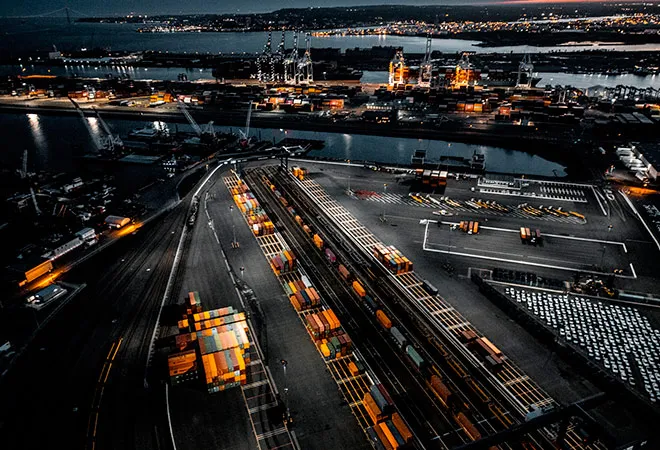
As the socioeconomic shocks of COVID-19 spread across the world, one of the hottest issues is the security of multinational supply chain, accompanied by deep concerns over the momentum of globalization and big power relations in post-pandemic context.
In wake of the outbreak of COVID-19, first waves of shocks have been imposed on supply chains of enterprises. China has been serving as the world’s largest exporter of goods and manufacturing center, but enterprises had to suspend production immediately after Wuhan’s city lockdown and level-1 emergency response in cities across China. This led up to break-up or contraction of their export supply chains. Panic was also triggered along with the suspension of transportation and industrial production in Italy and South Korea. While the former has been serving as the world’s most important textile and fashion garment production and design center, the latter is mid- and high-end semiconductor component manufacturing hub in Asia. By mid-March,
more than 30 countries announced national emergency, amplifying the shocks on global supply chain. In the US, the world biggest consumer goods market, its lockdown and abrupt shrinking of demand also led up to losses of orders undertaken by producers across the world.
Admittedly, these short-term shocks alone are not enough to shape fundamental changes to global supply chain. But they’ve been superimposed on existing changing momentum of multinational supply chain, thus incurring unprecedented changes since the 1950s.
Looking back into history, the great emergence of multinational corporations in postwar era, along with their production internationalization, led up to global flows and optimal composition of production factors since the latter half of the 20th century. The global network of raw material purchases, transition into semi-products and finished items, as well as sales of end products to consumers’ hands, have vigorously promoted economic globalization. In this process, the pattern of international trade and labor division is decided by different countries’ different resource endowment and comparative advantage. It’s increasingly prominent that today when we talk about strategic power competition, it’s less relevant to military race, but increasingly about utilizing one’s resource endowment and comparative advantage to build a complete industrial chain and seize advantage from lower to upper ends. Positioning oneself in global industrial and supply chains has gained unprecedented significance.
Major economies across the world have all started to adjust their industrial and supply chain strategies before COVID-19, and they continued to issue policies after the pandemic outbreak. The essence is to seize advantageous position in global industrial chain while guaranteeing flexibility of supply chain and national security. For instance, the Trump administration has released unprecedentedly comprehensive industrial policies in American history since late 18th century, aiming to realize direct, vertical control of entire global industrial chain, encompassing resuming labor-intensive industries, sustaining capital-intensive ones, and maintaining absolute dominance in
cutting-edge technologies such as AI, Advanced Manufacturing, Quantum Information Science and 5G. Since 2017, Washington has also a series of strategies to improve the buildup and risk assessment of supply chains, especially in high-end and defense sectors.
In Europe,
the UK focuses its long-term and comprehensive supply chain strategy on innovation-driven supply chain development to lift its manufacturing advantages and on financial support and industrial cooperation to improve SMEs’ competitiveness. In Germany, technological measures are emphasized to guarantee the efficiency and security of its supply chains. Due to uncertainties brought by COVID-19,
more preemptive measures have been released to prevent hostile takeovers of German companies by foreign capital.
While the short-term effects of COVID 19 on multinational supply chain — mainly mounting costs of global flow of human and commodities — could be reversed in post-pandemic world, the momentum of intensifying race and conflict along global industrial and supply chain will continue to be the most essential facet of strategic competition among major powers. Take China-US relationship for instance. The nature of ongoing US-China strategic competition is a race between a US that is trying to seize back the dominance of entire industrial chain and a China witnessing proactive industrial upgrading. After 40 years of reform and opening-up, China has quitted the mode of purely relying on labor-intensive or resource-intensive development, and climbed toward the upper end of global industrial chain. This has contributed to not just fundamental structural change of the Chinese economy, but also the “new normal” of strategic power competition.
Following the pandemic outbreak, politicians in Washington have portrayed the pandemic as a stress test to
“de-China” in multinational supply chain, and emphasized that
Coronavirus would help to accelerate the return of jobs back to North America. How to wisely navigate the challenges in industrial transition, live with the “new normal” of intensifying strategic competition along multinational industrial and global chains, as well as contribute to healthier regional and global economic geometry will be a major task facing Chinese economy in post-COVID 19 era.
Specifically, China faces several pivotal tasks. First and foremost is to re-identify its advantages in global supply chain and grasp the opportunity of early recovery from socioeconomic shocks imposed by the pandemic, so as to release its vigor of resource endowment and satisfy global demand. In this regard, China’s advantages include stable and efficient socioeconomic environment, a complete industrial system, rich intellectual resources, fast and convenient logistics, and a vast domestic market. Though China is losing the abundance of cheap labor, various resource factors can be better identified and used.
Second, technological innovation must be further consolidated. According to
Global Value Chain Development Report 2019, China is playing an increasingly important role as both supply and demand hub in traditional trade and simple global value chain networks. The nation needs to seize revolutionary opportunities, especially in digital economy, to shape new industrial types and enhance the competitiveness of Chinese enterprises. As long as China is capable of providing the world with of high-quality and low-price products, it will be closely engaged with other economies, and its position in global industrial and supply chains will become more prominent.
Last but not least, China should strengthen the construction of trans-border cooperative industrial parks.
In its meeting on July 30, 2020 expected to provide signals for economic work in rest months of 2020 and for upcoming 14th Five-Year Planning, the CPC Central Committee Political Bureau stressed the need to “fight a protracted war” to steer the world’s second biggest economy and maintain strategic focus for high-quality development amid full uncertainties. A new development pattern of “dual circulation”, which means taking domestic market as the mainstay while facilitating better interconnectivity between markets at home and abroad, has been proposed for economic resilience and sustainable development. In order to achieve this new “dual circulation” development pattern, one significant pillar is to build up high-level overseas industrial parks that integrate the wisdom and experiences of China and partner countries. This helps offset strikes from the pandemic on international production capacity cooperation. It will also stimulate the dual direction cooperation of more Chinese enterprises “going global” and foreign companies “coming in”, generating reciprocal symbiosis in global supply chain in post-COVID 19 period.
The views expressed above belong to the author(s). ORF research and analyses now available on Telegram! Click here to access our curated content — blogs, longforms and interviews.



 As the socioeconomic shocks of COVID-19 spread across the world, one of the hottest issues is the security of multinational supply chain, accompanied by deep concerns over the momentum of globalization and big power relations in post-pandemic context.
In wake of the outbreak of COVID-19, first waves of shocks have been imposed on supply chains of enterprises. China has been serving as the world’s largest exporter of goods and manufacturing center, but enterprises had to suspend production immediately after Wuhan’s city lockdown and level-1 emergency response in cities across China. This led up to break-up or contraction of their export supply chains. Panic was also triggered along with the suspension of transportation and industrial production in Italy and South Korea. While the former has been serving as the world’s most important textile and fashion garment production and design center, the latter is mid- and high-end semiconductor component manufacturing hub in Asia. By mid-March,
As the socioeconomic shocks of COVID-19 spread across the world, one of the hottest issues is the security of multinational supply chain, accompanied by deep concerns over the momentum of globalization and big power relations in post-pandemic context.
In wake of the outbreak of COVID-19, first waves of shocks have been imposed on supply chains of enterprises. China has been serving as the world’s largest exporter of goods and manufacturing center, but enterprises had to suspend production immediately after Wuhan’s city lockdown and level-1 emergency response in cities across China. This led up to break-up or contraction of their export supply chains. Panic was also triggered along with the suspension of transportation and industrial production in Italy and South Korea. While the former has been serving as the world’s most important textile and fashion garment production and design center, the latter is mid- and high-end semiconductor component manufacturing hub in Asia. By mid-March,  PREV
PREV


